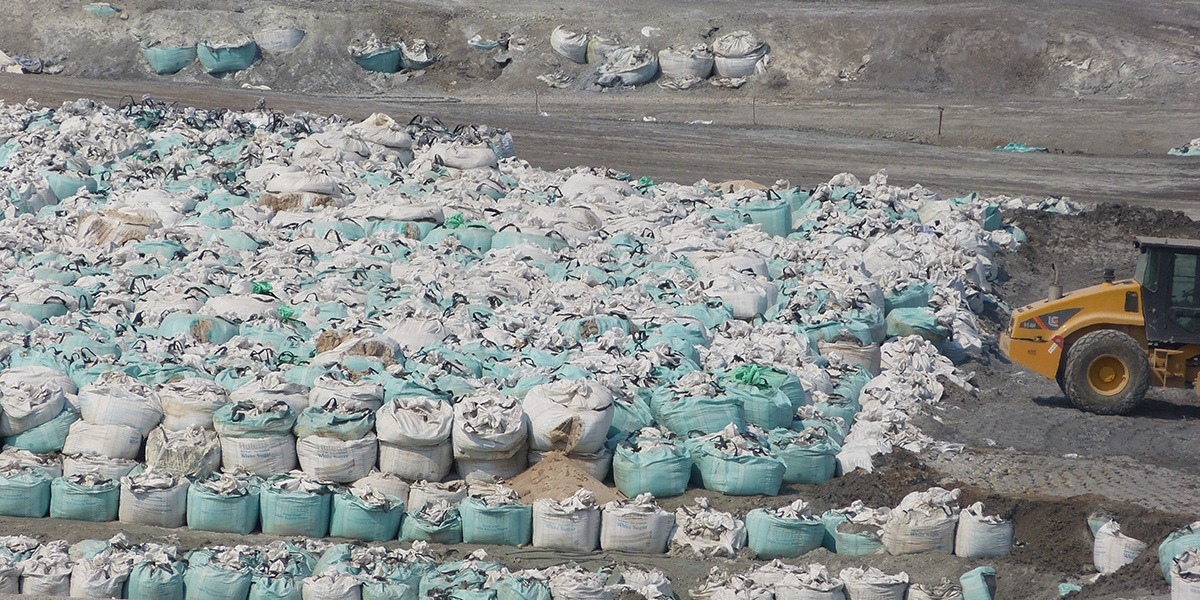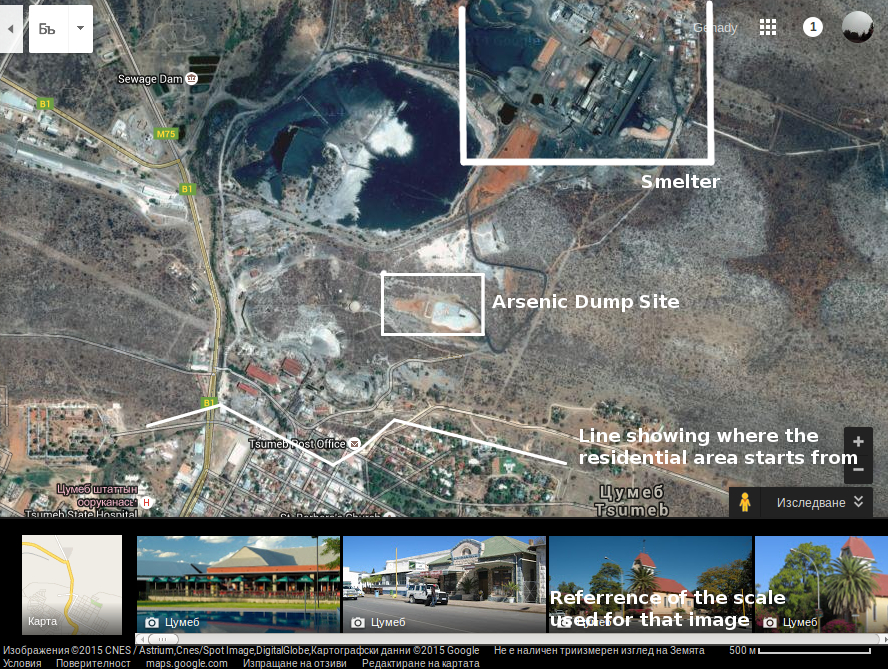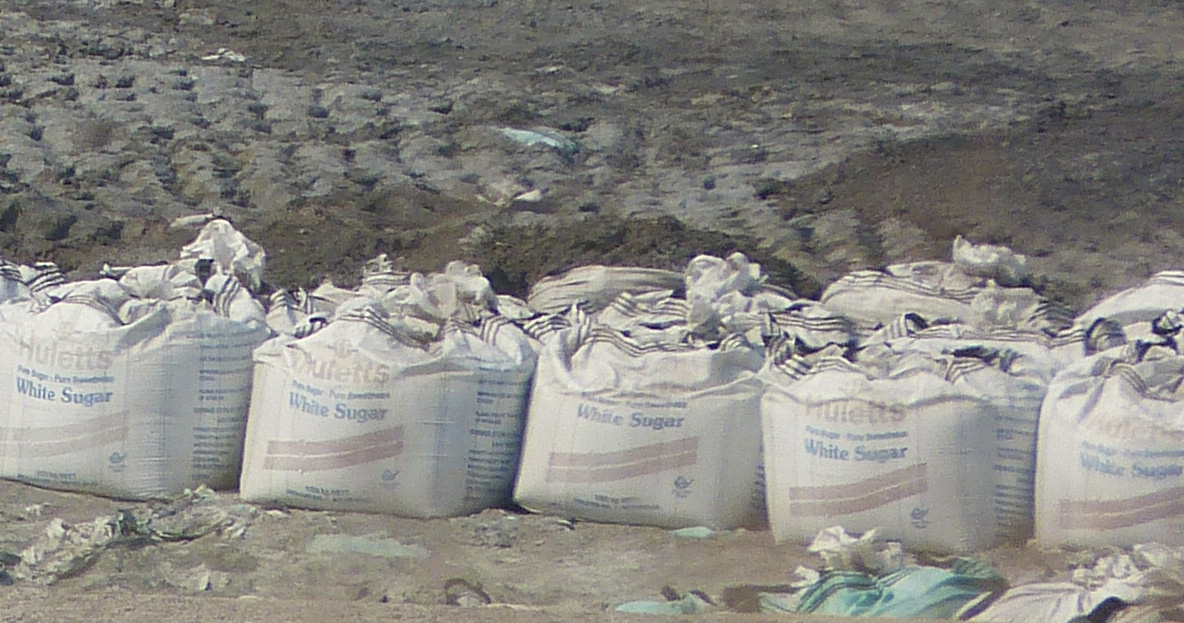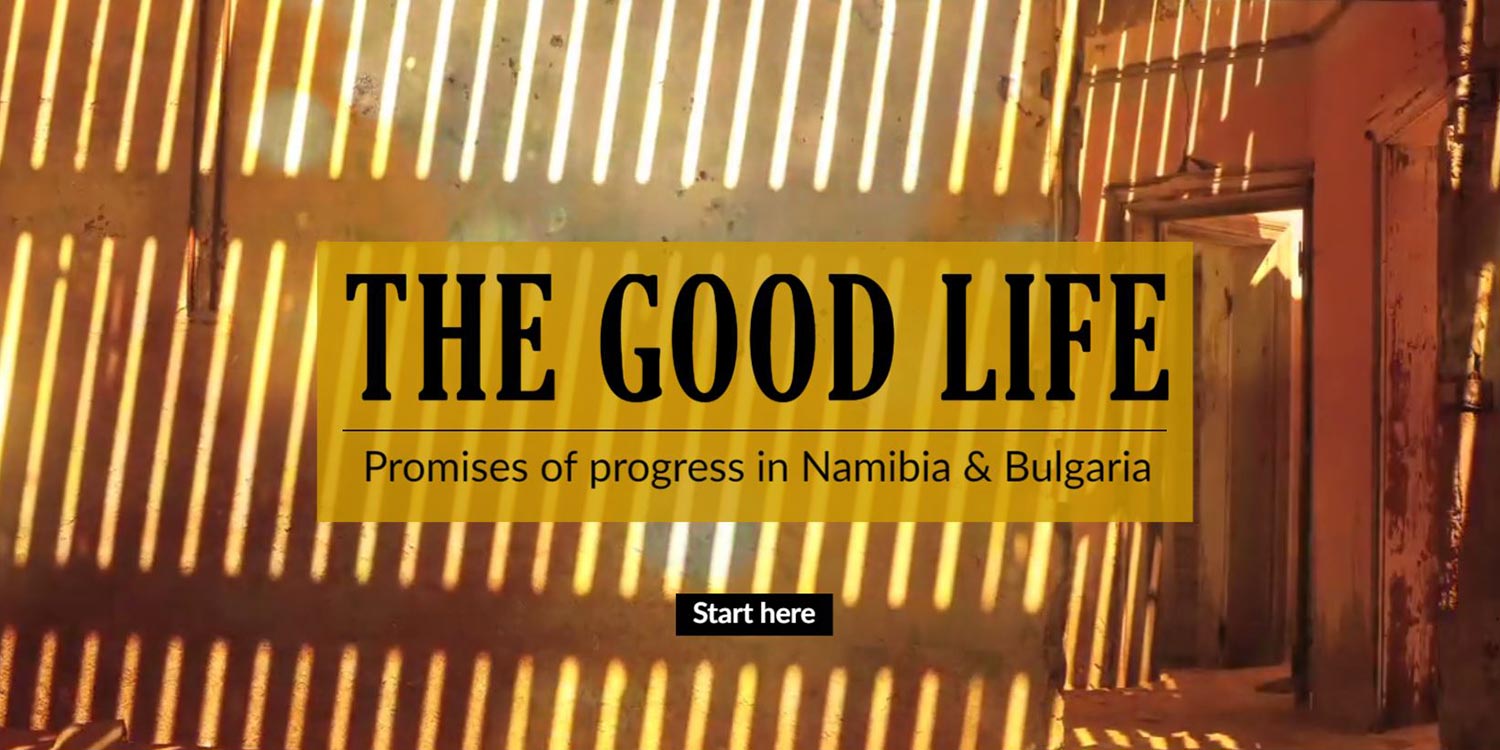The new gold mine in Krumovgrad boasts environmental performance and social responsibility, yet there are black spots along the path of the Bulgarian gold around the globe.
Dimitar Sabev, Guest author | 16 January 2019

A closeup of the Tsumeb waste disposal site. Clearly visible are the damaged bags containing residue from the smelter.
This is an extended version of an article that first appeared on The Ecologist with minor edits for coherence.
The technologies applied in the new gold mine in Krumovgrad rate among the most advanced in the world, states Lyubomir Haynov, Operation Director of the local branch of the Canadian ore mining company, Dundee Precious Metals (DPM). Konstantina Gradeva-Vassileva, the company’s Director for Sustainable Business Development, agrees: “We have learnt a lot about the environmental and social impact of mining”. For the past 15 years since Dundee extracts ores in Bulgaria, the company’s relationships with the public and authorities have truly evolved.
The turmoil at the end of the totalitarian regime ceased the operations of the Chelopech ore mine, one of the biggest deposits of gold and copper in Europe. DPM, controlled by the Canadian billionaire Ned Goodman, bought its concession rights in 2003 for USD 26 million, and in several years it scored annual sales amounting to hundreds of millions. Yet due to the stark public dissent, the company failed to expand its production in Bulgaria because of its use of cyanide technologies. The Canadians acquired instead a smelter in Namibia where they ship the Chelopech concentrate containing gold, copper, and large amounts of arsenic.
Jobs and dust
The ore mine in Krumovgrad in the Eastern Rhodope Mountain is the next phase of DPM expansion. Firstly, the locals opposed the new extractive site on their rural land. Yet the prospects of employment in a region with scarce opportunities, in addition to a cunning PR strategy and some pressure from the authorities, gradually changed their attitudes. Vasvi Ibriam, the mayor of the Sarnak village in the viccinity of the gold mine says: “It’s true, people get annoyed by the rock blasts and the dust. But we have to endure this for the jobs’ sake. In my village alone, there are already three or four men employed”. According to Vasvi, every man who wants to work now may get a job in Krumovgrad – not only at Dundee and its contractors but also at the new rubber factory or in the new big municipal projects.
Firstly, the locals opposed the new extractive site on their rural land. Yet the prospects of employment in a region with scarce opportunities, in addition to a cunning PR strategy and some pressure from the authorities, gradually changed their attitudes.
Unofficially, the operation in Krumovgrad will commence in full in the spring of 2019 with the opening of the flotation factory, a couple of months delay from the initial schedule. The technology envisages lower environmental impacts: there will be no tailing pond, and the water used in the production process will be purified to drinking quality before poured back into the Krumovitsa River. “We are certainly the first ore mine (in Bulgaria) to do this”, proudly states Haynov.
The online system for environmental monitoring developed by the company reveals many cases of overshooting the allowed limits of fine particles around the mining site – yet this is the inevitable price of employment. In addition, DPM created a fund worth USD 5 million to back up the small and medium-scale local businesses. This social support might be inspired by the EBRD – last year the development bank entered the Dundee family by swapping an extended credit line for a 10-% share in the company.
No doubt, the investor’s efforts in Chelopech and Krumovgrad deserve praise, but still the Canadian company cannot turn into a saint overnight – neither in environmental nor in social or fiscal sense.
Toxic piles in Africa
In the summer of 2015, a mission of Bulgarian environmentalists visited the town of Tsumeb in Namibia to get a firsthand view of the DPM smelter situated there. Unlike Bulgaria where public communications seem to be of highest priority to the company, the management of the African branch denied a meeting with the European guests. Nevertheless, local activists assisted the mission in its inquiries, and it registered a number of setbacks during the transportation and stockpiling of the Chelopech concentrate.
Yet the biggest problem in Tsumeb turned to be the arsenic – both for the smelter’s staff and the local population. The polymetallic ores of Chelopech have a very high (over 5 %) arsenic content, and the technology used in the smelter is not suited to process them safely. According to the International Agency for Research on Cancer, arsenic and its compounds are “group 1 carcinogens”. When the high-grade arsenic concentrates from Bulgaria started to enter the Namibian smelter, the workers felt the difference and energetically protested. The authorities felt obliged to intervene, and production volumes were halved. Yet from the beginning of 2014, the volumes were not only restored to their former level but also additionally doubled.
In 2012, on the request of the union activist Oscar Kakunga (latter dismissed) a full-scale health examination of the smelter’s workers took place. 1 722 probes were taken, and in 69 % of the cases the concentration of arsenic in the workers’ blood and urine exceeded 100 μg/g. In the neighboring South Africa, the reference value for over-exposure to arsenic is 50 μg/g, yet since the exposure to arsenic is extremely hazardous, the World Health Organization holds that “a safe level of arsenic (in air) cannot be established”. The smelter’s management states that after 2014 the levels of arsenic in the workers’ urine have diminished without citing concrete numbers.
Johannes decided to have an independent health check in South Africa. The doctor who examined him said, “You are too young to kill yourself with this job”.
Instructive is the experience of Johannes Amutenya, now 33-years old, who has worked for some months with the Chelopech concentrate. Prior to DPM acquiring the smelter, the staff underwent health examinations every two months, but with the new owner – only twice a year. The workers received no more documents on their health status but only verbal assessment that everything is OK. Johannes decided to have an independent health check in South Africa. The doctor who examined him said,” You are too young to kill yourself with this job”.

The Bulgarian mission managed to get hold of photos of the storage site for the surplus arsenic (several thousand tons of arsenic trioxide from Tsumeb are sold to Malaysia and South Africa to be used as pesticides – a practice not allowed in the EU). Only several hundred meters from residential buildings, thousands of tons of arsenic are stored in ordinary sugar bags in the open – decaying under the African sun.

Genady Kondarev, who took part in the Tsumeb investigation, recalls, “There was a colossal quantity of toxic dust piled on the site. After a couple of years under the hat of Dundee, this facility had almost entirely used up its storage site for arsenic waste. Since the shocking results of the medical tests in 2012, we haven’t heard about newer health checks with publicly accessible results regarding the arsenic levels in the worker’s organisms”.
FEATURE
The good life – Interactive documentary on Tsumeb and Chelopech
The documentary explores the meaning of progress, development and well-being in two places on two continents that are connected through the Chelopech copper mine and the Tsumeb smelter.
Slow boat to China
In addition to its low environmental standards and cheap labor, Namibia attracts foreign investors with zero tax rates. The smelter of Tsumeb lies in a Special Processing Zone, freed from corporate taxes and VAT. The Human Development Index ranks Namibia 129th in the world, yet DPM – and thus the shareholder EBRD – do not feel embarrassed by the fact that they deny the national budget the funds that might be used for healthcare or education purposes.
Until recently, the output of the smelter was brought to the market by the Louis Dreyfus Company. This huge Switzerland-based company constitutes the letter “D“ in the so-called ABCD group comprising four gigantic corporations that dominate the world’s food trade. The Metal Department of Louis Dreyfus had operations in Peru, Namibia, Australia, Mexico, China etc., and scored high profits. However, due to some strategic reasons, in the middle of 2018 this metal division was sold to the Chinese NCCL Natural Resources Investment Fund. Prior to this, Dundee Precious Metals had stated that it has a long-term trade contract with Louis Dreyfus. Most probably, the new destination of Bulgarian gold is China.
The Tsumeb smelter processes – in addition to the Chelopech concentrate – also concentrates from the El Brocal mine in Peru (they have even higher arsenic content) as well as other sources. The output of the smelter is not pure metal but “black copper” – an alloy refined up to 98.5 %, which contains not only copper and gold but also several valuable rare earth metals. It is a mystery where the final processing to marketable ingots is taking place and, correspondingly, who collects the value of the rare earths unaccounted neither in Bulgaria nor in Namibia. The only hint we get is from the corporate website of DPM stating that it supplies „refineries in Europe and Asia”.
The UNCTAD database – the United Nations body for trade and development – reveals that up to 2017 the annual copper exports from Namibia to Switzerland amounted to an average of USD 150 million, besides USD 100 million copper concentrates. This trade flow will probably turn to Asia with the selling of the metal division of Louis Dreyfus. China already buys from Namibia uranium ores and other radioactive materials worth USD 100 million per annum.
The metal flows passing Namibia evaporate in enormous global merchant companies. Yet it is clear that both producers and intermediaries use to exploit the zero tax rates and the “liberal” environmental legislation in the African country. Even the EBRD – the development bank that explicitly states its environmental and social commitments – sees nothing worrying happening between the model ore mines in Bulgaria and the shiny golden ingots in the treasury.
Black Tax Holes
… the state manages to collect only 6% of the value of the gold extracted from its earth.
Dundee is an old enthusiast of tax optimizing. For the six years between 2012 and 2017, the ore mine in Chelopech generated nearly EUR 1.1 billion incomes and EUR 380 million profits before taxes. For the whole period, the company paid the Bulgarian budget EUR 38 million in corporate taxes and EUR 30 million in concession fees. Excluding the taxes and social contributions on salaries, the state manages to collect only 6 % of the value of the gold extracted from its earth.
Moreover, it is disputable whether the real profit of DPM in Bulgaria is only EUR 380 million for six years. The company declares heavy depreciations; pays interests on loans granted by connected entities, has administrative expenses in order of EUR 100 million, there are also many other expenses that raise doubts. The issue of unaccounted rare metals was presented above.
Tax optimization gathers pace when profits leave the low-tax Bulgarian environment. The Bulgarian Trade Registry reveals that DPM uses two companies registered on the Curacao Island and another company based on the British Virgin Islands – both jurisdictions are well-known tax havens. The latter company called Vatrin Investment Ltd. is 100 % owned by a cooperative with headquarters in the Netherlands – Dundee Precious Metals Cȍoperatief U.A. According to the Dutch trade law, there are several cases when cooperatives are not obliged to pay dividend taxes, there is also an option to avoid the tax on profits.
For this scheme to be applied the Dutch cooperative must include another company registered in the Netherlands – DPM also owns such. It is worth mentioning that the rights to develop the golden deposit in Chelopech in 2003 were acquired by another Caribbean branch of the Canadian extractive company, this time abiding in the Barbados Island.
When having such an elaborate offshore network it is no wonder that in 2016, the Chelopech ore mine recorded a profit of EUR 35 million after taxes, and the mother company based in Toronto declared USD 147 million loss. The same happened one year before: the net profit from Chelopech was EUR 45 million, but that of DPM in Canada – only USD 7.6 million.
Across the seas
The ores and concentrates processed in countries with low environmental standards arrive there by ship. Millions tons of crushed rocks circle around the globe in pursuit of somewhat cheaper smelting while marine transportation emissions remain excluded from the global climate schemes. They consist far not only of carbon dioxide, but also of soot and Sulphur and Nitrogen oxides. The German Naturschutzbund calculated that marine transportation is responsible for 22 % of the world’s Nitrogen oxides emissions, and the soot for 50 % of the Arctic warming. The highest allowed Sulphur content in the ship fuels is 3 500 times above that of car fuels.
A hundred thousand tons of concentrate from Chelopech travel for 9 000 miles every year to reach Namibia, that same amount arrives in Tsumeb from other places, including the Pacific coast of South America. Europe closes its eyes not only for the accompanying contamination but also for the development impacts: poor countries specialize in delivering raw materials, the processing remains for regions with loose environmental standards, and the surplus value in the final phases is being collected by the rich. The free trade agreements of the EU just cement the inequality in global industrial development.
The Krumovgrad ores will not be shipped to Tsumeb since their arsenic content is low. Indeed, there is something different in their case. A long and hard opposition of the stakeholders at last guaranteed the acceptable quality of the DPM extractive operations. Daniel Popov, a Bulgarian NGO mining expert, said: “The management of DPM saw potential in being environmentally responsible. The right person in the right place and time was Adrian Goldstone, the DPM Sustainability Director, who saw the potential of being environmentally responsible. Krumovgrad is a lesson of how interacting with the locals and the NGOs might alter the initial business plans until they become acceptable for the whole society”.
Never miss an update
We expose the risks of international public finance and bring critical updates from the ground – straight to your inbox.
Institution: EBRD
Location: Bulgaria | Namibia
Tags: Krumovgrad | Tsumeb | gold mining | human rights


